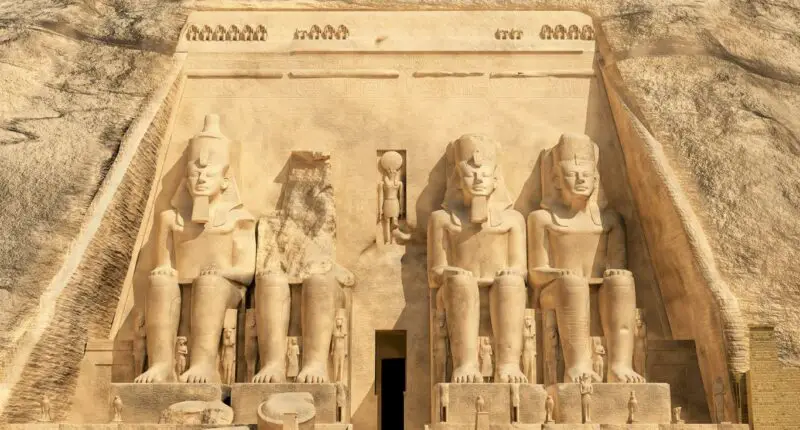The ancient civilization of Egypt remains one of the world’s most fascinating and enduring legacies. Its rich history is characterized by periods of greatness and prosperity, as well as moments of decline and tragedy. From the emergence of the first dynasty around 3100 BCE to the final fall of the Ptolemaic Kingdom in 30 BCE, the story of ancient Egypt is a complex and intriguing tale of power, wealth, religion, and politics. The rise and fall of the Egyptian Empire is a fascinating study in the shifting sands of power, and the ways in which a great civilization can be both sustained and undone by the forces of history. Whether it was through internal strife, external invasions, or economic instability, the story of ancient Egypt is a testament to the enduring impact of a civilization that once dominated the region and exerted a profound influence on the world.
This blog post will explore the key events and developments that shaped the rise and fall of the Egyptian Empire, and consider the enduring legacy of this ancient civilization. From the construction of the pyramids to the legacy of Cleopatra, we will delve into the glory and tragedy of a civilization that left its mark on history.
The Rise of The Egyptian Empire

The rise of the Egyptian Empire can be traced back to the unification of Upper and Lower Egypt under the rule of King Narmer in the 31st century BCE. This marked the beginning of the First Dynasty, which saw the establishment of a centralized monarchy and the creation of a strong and organized state. Over the next few centuries, Egypt experienced a period of remarkable stability and prosperity, with the development of monumental architecture, the growth of trade and commerce, and the strengthening of the pharaoh’s power.
One of the most notable achievements of this early period was the construction of the pyramids, which stand as a testament to the ingenuity and architectural skill of the ancient Egyptians. These massive structures, built as tombs for pharaohs and their consorts, remain some of the most impressive architectural feats of all time.
The Old Kingdom, which lasted from the 27th to the 22nd century BCE, is often referred to as the “Age of the Pyramids” and was characterized by the construction of the Giza Necropolis, including the Great Pyramid of Giza. This period also saw the growth of the cult of the pharaoh, who was considered a deity on earth, and the development of a complex religious and ideological system that underpinned the stability and power of the state.
Rise of the Egyptian Empire was a remarkable achievement, marked by stability, prosperity, and a cultural and artistic legacy that has endured to this day. Despite its eventual decline, the impact of ancient Egypt on the world remains profound, and its story continues to captivate and inspire people across the globe.
The Pyramids
The pyramids of ancient Egypt are some of the most recognizable and impressive structures in the world. These massive stone structures were built as tombs for pharaohs and their consorts and stood as symbols of the power and wealth of the pharaohs.

Most famous pyramids are located in Giza, on the outskirts of modern-day Cairo. The Great Pyramid of Giza, also known as the Pyramid of Khufu, is the largest and most famous of the pyramids, and is considered one of the Seven Wonders of the Ancient World. It was built during the Fourth Dynasty, around 2560 BCE, and was originally 146 meters tall, making it the tallest structure in the world for more than 4,000 years.
The construction of the pyramids was a massive undertaking that required the mobilization of thousands of workers and the transport of huge blocks of stone from quarry sites located as far as 500 kilometers away. The exact methods used to build the pyramids are still the subject of much debate and speculation, but it is widely believed that ramps and sledges were used to transport the blocks of stone to the construction site.
The pyramids were not just impressive structures, but also had a profound religious and ideological significance. They were believed to be the homes of the pharaohs in the afterlife and were designed to protect and preserve their bodies for eternity. The interiors of the pyramids were filled with elaborate passages and chambers, including the burial chamber, which housed the pharaoh’s sarcophagus.
Legacy of the pyramids is far-reaching and enduring, and they continue to be a source of fascination and wonder for people all over the world. The pyramids of ancient Egypt are a testament to the ingenuity, architectural skill, and religious beliefs of the ancient Egyptians, and remain an important part of the world’s cultural heritage.
The Fall of The Egyptian Empire

The fall of the ancient Egyptian Empire was a complex and gradual process that was characterized by a combination of internal decay and external invasions. The reasons for the empire’s decline were many and varied, including political instability, economic problems, military defeat, and religious and cultural changes.
The First Intermediate Period, which lasted from 2181 BCE to 2040 BCE, marked the first major crisis in ancient Egyptian history. This period was characterized by the fragmentation of the central authority, with multiple regional powers vying for control. It was also marked by a period of cultural and religious change, with the rise of the sun god Ra and the growth of the cult of Osiris, the god of the afterlife.
The Middle Kingdom, which began in 2040 BCE, saw the reunification of the country and the restoration of the pharaoh’s power. However, this period was followed by the Second Intermediate Period, which lasted from around 1650 BCE to 1550 BCE. This period was marked by the rise of the Hyksos, a group of foreign invaders who established control over much of Lower Egypt and ruled from their capital in Avaris.
The New Kingdom, which lasted from 1550 BCE to 1069 BCE, marked the height of ancient Egyptian power and wealth. During this period, the pharaohs extended their rule over neighboring lands and established a vast empire that included parts of Nubia, the Levant, and Libya. However, despite this period of military and economic expansion, the New Kingdom was also marked by a period of internal decay and political instability, with a succession of weak pharaohs and the growing influence of the priestly class.
The final fall of the Egyptian Empire came with the conquest of Alexander the Great in 332 BCE, which marked the end of the pharaonic era and the beginning of the Hellenistic period. The Ptolemaic Kingdom, which was established after Alexander’s death, ruled Egypt for the next three centuries, until the death of Cleopatra VII in 30 BCE, when the country became a province of the Roman Empire.
Reasons For The Fall of The Egyptian Empire

The fall of the ancient Egyptian Empire was a complex process that was influenced by a variety of internal and external factors. Some of the main reasons for the empire’s decline include:
- Political Instability: Throughout its history, ancient Egypt was plagued by political instability and weak leadership. The frequent changes in leadership, the struggle for power among different factions, and the lack of a clear succession plan all contributed to the decline of the empire.
- Economic Problems: The ancient Egyptian economy was heavily reliant on agriculture and was vulnerable to fluctuations in the Nile River’s water levels and natural disasters like drought and famine. Economic problems, such as inflation and food shortages, led to social unrest and weakened the empire’s ability to defend itself against external threats.
- Military Defeat: The ancient Egyptian Empire was vulnerable to military invasion and defeat, and throughout its history, it was invaded by various neighboring peoples, including the Hyksos, the Nubians, and the Persians. These invasions not only caused significant damage to the country’s infrastructure, but also weakened its military power and reduced its ability to defend itself.
- Religious and Cultural Changes: Ancient Egypt was deeply religious and its religious beliefs and practices played a significant role in its politics and culture. Over time, changes in religious beliefs and practices, as well as changes in the political landscape, led to a decline in the empire’s cultural and religious unity.
- Environmental Changes: Changes in the environment, such as shifts in the Nile River’s water levels, can have a profound impact on ancient civilizations. The ancient Egyptians were heavily dependent on the Nile for their agriculture, and any changes in its water levels could have a significant impact on the country’s food production and economy.
Conclusion
The rise and fall of the ancient Egyptian Empire is a tale of both glory and tragedy. At its height, the empire was a superpower, renowned for its wealth, military prowess, and cultural achievements. The pyramids, which still stand today as a testament to the empire’s greatness, are among the most iconic structures in the world and symbolize the height of ancient Egyptian civilization.
However, the empire’s eventual fall was a slow and complex process, marked by internal decay and external invasions. Despite its greatness, the empire was plagued by political instability, economic problems, and weakened leadership, which ultimately led to its decline.
Despite its eventual fall, the legacy of the ancient Egyptian Empire endures. Its art, architecture, and cultural achievements continue to inspire and captivate people around the world, and its story remains one of the most fascinating and enduring in human history. Whether viewed as a tale of glory or a tragedy, the rise and fall of the ancient Egyptian Empire is a reminder of the enduring power of human achievement and the fragility of empires.
Also Read: Top 10 Movies based on Egyptian Mythology



